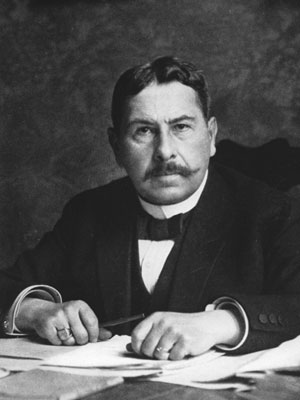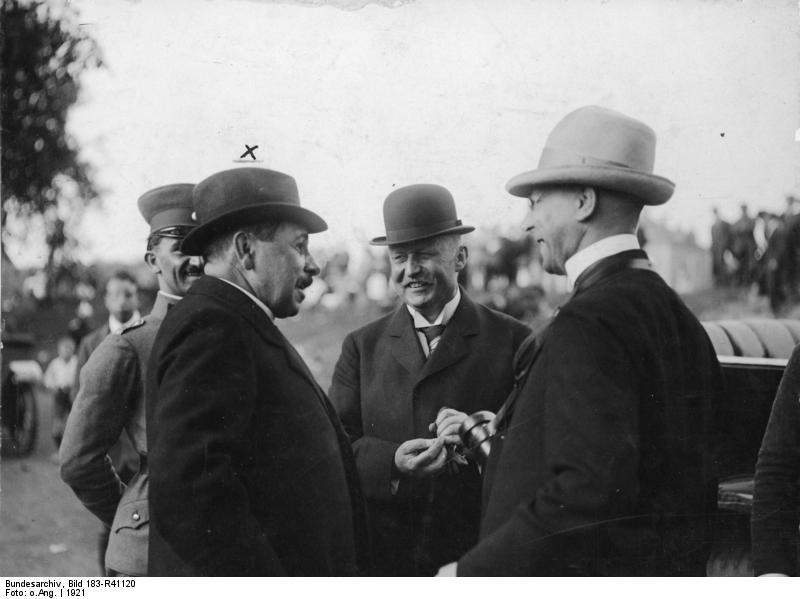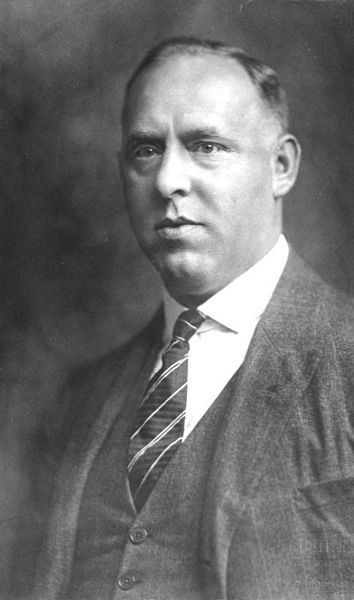<Back to Index>
- Minister President of Bavaria Gustav Ritter von Kahr, 1862
- Member of the National Socialist German Workers Party Gregor Strasser, 1892
PAGE SPONSOR


Gustav Ritter von Kahr (November 29, 1862 – June 30, 1934) was a German right wing conservative politician, active in the state of Bavaria. He was instrumental in the failure of Adolf Hitler's Beer Hall Putsch in 1923, and was subsequently put to death more than ten years later in the Night of the Long Knives.
Born in Weißenburg in Bayern, Kahr studied law and worked as a lawyer before entering politics. Politically, he was a monarchist and had links to the Catholic BVP, though he was a Protestant and never joined any party. In 1917 he became head of the provincial government of Upper Bavaria, but lost this post in the German Revolution of 1918. However, the revolution was short lived and order was restored.
After March 14, 1920, Kahr succeeded Johannes Hoffmann as Prime minister of Bavaria. Kahr came into office under military influences as an indirect result of the Kapp Putsch of March 13 in Berlin. The most powerful party in Bavaria, the Bavarian Volkspartei, was then in a state of much anxiety as a result of the experiences of Bolshevism, anarchy and violence through which Munich had passed in the spring of 1919. The ministry presided over by the moderate socialist Hoffmann had succeeded in quelling Bolshevism with the aid of Republican troops from Prussia and Württemberg, but the great majority of the Bavarian Catholic Volkspartei, as well as liberals of various shades, not to speak of the royalists and reactionaries, wanted further guarantees against a recurrence of the Bolshevist terror.
The
Kapp Putsch in Berlin gave the signal for political action in Munich,
and at a midnight sitting the Bavarian socialist ministry was somewhat
unceremoniously hustled out of office — it is alleged under military
pressure — and a coalition cabinet under Kahr installed. The coalition
included reactionary conservatives whose influence became more and more
predominant. They were backed up by formerly liberal Bavarian journals
which had been bought up by Prussian industrialists.
Kahr's administration was essential in turning Bavaria into a "Ordnungszelle" (cell of order), giving room for all kinds of right wing groups. He also supported separatist forces who aimed at Bavarian secession from Germany, but after the German government passed a decree for the protection of the Republic against right wing extremists, Kahr resigned on 1 September 1921.
In September 1923, following a period of turmoil with assassinations and political violence, Prime Minister Eugen von Knilling declared martial law and appointed Kahr, who had returned to his provincial post, as Staatskomissar (state commissioner) with dictatorial powers. Together with Bavarian State Police head Colonel Hans Ritter von Seisser, and Reichswehr General Otto von Lossow, he formed a triumvirate.
That year, many right wing groups wanted to emulate Mussolini's "March on Rome" by a "March on Berlin". Among these were the wartime General Erich Ludendorff and also the Nazi (NSDAP) group, led by Adolf Hitler. Hitler decided to use Ludendorff as a figurehead in an attempt to seize power in what was later known as the "Hitler Putsch" or Beer Hall Putsch. Hitler and Ludendorff sought support of Kahr and his triumvirate. However, Kahr had his own plan with Seisser (Seißer) and Lossow to install a nationalist dictatorship without Hitler. Kahr warned the 'patriotic associations' against independent action.
Hitler was determined to act before the appeal of his agitation waned. So on November 8, 1923, Hitler and the SA stormed a public meeting of 3,000 people which had been organized by Kahr in the Bürgerbräukeller, a large beer hall in Munich. Hitler interrupted Kahr's speech and announced that the national revolution had begun, declaring the formation of a new government with Ludendorff. While waving his gun around, Hitler demanded the support of Kahr, Seisser and Lossow. Hitler's forces initially succeeded at occupying the local Reichswehr and police headquarters; however, neither the army nor the state police joined forces with Hitler. Kahr, Seisser and Lossow were briefly detained but then released. The men quickly withdrew their support and fled to join the opposition to Hitler. During the night and unknown to Hitler, they prepared the resistance against the coup. The following day, Hitler and his followers marched from the beer hall to the Bavarian War Ministry to overthrow the Bavarian government on their "March on Berlin", but the police dispersed them. Sixteen NSDAP members and four police officers were killed in the failed coup.
Kahr's role in the failure of the coup cost him the support of right wing nationalist forces in Bavaria and after Hitler's trial revealed his administration's involvement in the preparations of the coup, he was forced to resign from his post as Staatskommissar in February 1924. After this, Kahr served as President of the Bavarian law court for reviewing administrative acts and, having sunk into relative obscurity, retired from public service three years later.
On June 30, 1934, during what became known as the Night of the Long Knives, Kahr was punished for his "treason" during the Beer Hall Putsch. He was abducted in Munich and murdered by SS members - hacked to death with axes and thrown into a swamp near Dachau. His family was forbidden to wear mourning clothes, according to Richard Hanser in his 1970 book, Putsch.

Gregor Strasser (also Straßer) (May 31, 1892 – June 30, 1934) was a politician of the National Socialist German Workers Party (NSDAP). He was murdered in Berlin during the Night of the Long Knives.
Gregor Strasser and his younger brother Otto were born into the family of a Catholic judicial officer who lived in the Upper Bavarian market town of Geisenfeld. He attended the local Gymnasium (high school) and after his final examinations, served an apprenticeship as a druggist in the Lower Bavarian village of Frontenhausen from 1910 until 1914. In 1914 he began to study pharmacy at Ludwig Maximilians University of Munich, suspending his studies in the same year to enlist as a volunteer in the German Imperial Army. Strasser took part in World War I, rising to the rank of First Lieutenant, and being decorated with the Iron Cross, First and Second Class.
In 1918, he resumed his studies at Friedrich - Alexander - University, Erlangen - Nuremberg and in 1919 he joined the rightist Freikorps led by Franz Ritter von Epp (1868 – 1932)
together with his brother Otto. He passed his state examination
successfully in the same year, and in 1920 started work as a pharmacist
in Landshut. Strasser established and commanded Sturmbataillon Niederbayern (English: Storm battalion Lower Bavaria), where young Heinrich Himmler served as his adjutant. By March 1920, Strasser's Freikorps was ready to participate in the failed Kapp Putsch. During that time, his brother Otto commanded a socialist Rote Hundertschaft (Red Group of a Hundred) to battle against this right wing "reactionary" coup d'état.
Soon Gregor Strasser was leading a völkischer Wehrverband ("ethnic defense union"), one of several such nationalist paramilitary groups. His group joined forces with the NSDAP (Nazi Party) in 1921, which had been founded in Munich in 1919 as the Deutsche Arbeiterpartei (DAP or German Workers' Party), and which changed its name to the Nationalsozialistische Deutsche Arbeiterpartei (NSDAP or National Socialist German Workers' Party) in 1920. His leadership qualities were readily recognized and he was soon appointed as regional head of the SA in Lower Bavaria. In November 1923 he took an active part in the miscarried Beer Hall Putsch. In a special part of the high treason trial against Adolf Hitler and his accomplices, Strasser was sentenced to one and a half years of Festungshaft (confinement in a fortress, which was regarded as an honorable detention in the German Empire) in Landsberg Prison by Volksgericht München I in April 1924. After a few weeks Strasser was released because he had been elected a member of Bavarian Landtag for the Nazi associated Völkischer Block on May 4, 1924. On December 7, 1924 he attained a seat in the Reichstag of the Weimar Republic. He had run under the party banner of the Deutschvölkische Freiheitspartei (German People's Freedom Party), which served as a substitute organization for the NSDAP (which was banned in Bavaria starting in November 1923 after the abortive putsch). Strasser kept this position until December 1932.
After the official refoundation of the NSDAP by Adolf Hitler in the Munich Bürgerbräukeller on February 26, 1925 Strasser became the first Gauleiter of Lower Bavaria / Upper Palatinate and, after the partition of this Gau, Lower Bavarian Gauleiter from October 1, 1928 until 1929. From June 30, 1926 until early 1928 he was NSDAP Reichspropagandaleiter (NSDAP Reich Leader for Propaganda) and from January 1928 until December 1932 he was the Nazi Reichsorganisationsleiter (Reich
Organization Leader). Gregor Strasser reorganized the whole NSDAP
structure, both in its regional formation and its vertical management
hierarchy. The Nazi Party became a strictly centralist organization with
the party's own control machinery and high propaganda capability.
Strasser's ideas for restructuring the Nazi Reich Organization
Leadership had been carried into effect by service regulations called Politische Organisation - P.O. - (Political Organization - P.O.) of the NSDAP on July 15, 1932.
After 1925, Strasser's outstanding organizational skill helped the NSDAP to make a big step from a marginal South German splinter party to a nationwide mass party, appealing to the lower classes and their tendency towards socialism. Its membership increased from about 27,000 in 1925 to more than 800,000 in 1931. Strasser established the NSDAP in northern and western Germany as a strong political association which quickly attained a higher membership than Hitler's southern party section. Moreover he arranged for the foundation of the Berlin SA (Stormtroopers) under Upper Silesian Nazi activist Kurt Daluege in March 1926. The party's own Foreign Organization (see NSDAP / AO) was formed on Strasser's initiative, and Dr. Hans Nieland was appointed its first leader on May 1, 1931. Together with his brother Otto, Strasser founded the Berlin Kampf - Verlag (Combat Publishing) arm in March 1926, which published among others the programmatic weekly journal Der Nationale Sozialist (The National Socialist) from 1926 until 1930.
The Strasser brothers ruled the Berlin party organization unchallenged and developed an independent ideological profile from the south German party wing around Adolf Hitler. They advocated - at first together with Gregor Strasser's close collaborator in Rhineland and Westphalia Joseph Goebbels - an anti - capitalist, social revolutionary course for NSDAP that was heavily affected by antisemitism and anti - Marxism at the same time. With the Arbeitsgemeinschaft Nordwest (Syndicate Northwest), a federation of north and west German NSDAP Gauleiter under his leadership (managing director was Joseph Goebbels) founded in 1925, Gregor Strasser had created an instrument to enforce the sociopolitical and economic ideas of the left NSDAP wing. But on February 14, 1926 Hitler asserted himself successfully against this "National Bolshevist" faction during the Bamberg Conference. This earned Hitler absolute leadership within the NSDAP. The disbandment of the syndicate was decreed by a directive from Munich on July 1, 1926.
It has been reported that Gregor Strasser had a brief affair with Geli Raubal and that Geli disclosed to him intimate details of Hitler's sexual habits and alleged impotence. If
true, it provides another motive for her murder (if in fact her death
was murder, not suicide) as such allegations would have been a threat to
both Hitler and the Nazi Party. At Geli's Catholic burial, the Priest
was Father Johann Pant. Pant later wrote (in 1939) to a French
newspaper, "From the fact I gave her a Catholic burial you can draw your
own conclusions".
The programmatic and personal rivalry with Adolf Hitler worsened dramatically when Reichskanzler Kurt von Schleicher offered Strasser the vice - chancellorship and the office of the Prussian Prime Minister in December 1932. Von Schleicher shrewdly hoped to disunite the NSDAP with Strasser's help and to pull the left Nazis around Strasser over to his national conservative side, as to prevent a revolution or takeover by Hitler. The plan failed because of Hitler's intervention, and resulted in Strasser's resignation from all party positions. According to William L. Shirer, this move upset the very foundations of the Nazi party, and could have put an end to their quest for power. Strasser was still a very powerful figure in the region in which he had built up power, and could have mobilized support in the region to turn people against the NSDAP. Instead, Strasser tired of the political struggle as well as the intense campaigning and took a restorative holiday in Italy. Hitler seized upon this opportunity to sack all members of the party loyal to Strasser. All new and remaining workers were summoned to sign an oath of loyalty to the Führer, and therefore, this abnegated any damage that the departure of an influential figure like Strasser could cause.
He continued acting as a publicist as he did before his disempowerment. From June 1931 until its ban on February 4, 1933 he published the weekly newspaper Die Schwarze Front (named after Otto Strasser's Black Front political organization), which made little impact on contemporaries because of its small circulation (10,000 copies).
His involvement in politics did not end completely however, and he had a minor role in von Schleicher's downfall. On January 4, the chancellor summoned the disaffected Strasser to visit President von Hindenburg. A few days later, Strasser expressed an interest in joining Schleicher's cabinet, which would significantly weaken the Nazi party. Schleicher was assured of Strasser's defection, and bragged to a visiting Austrian minister that the problem of the Nazi Party was solved and their rise had ceased. However, for some reason, Strasser had declined to join the cabinet. Schleicher had therefore failed to win over or divide the Nazis, and coupled with a morale boosting election campaign in Lippe, Hitler set about definitively undermining Schleicher, now knowing he did not have Strasser's help.
During the Nazi Party purge, which was called officially "Röhm - Putsch" by the Nazi propaganda (Night of the Long Knives), Strasser was imprisoned and then assassinated on Hitler's personal order by the Berlin Gestapo on June 30, 1934. The assassins shot through a window into Strasser's cell, eventually killing him. Fritz Günther von Tschirschky, one of Franz von Papen's staff members who was kidnapped and taken to Gestapo headquarters, claimed to be a witness to the murder. According to his memoirs, Strasser was murdered in an adjoining cell in the basement by an SS squad shooting at his temple and back of the head several times. Tschirschky could not watch the execution directly because guards were blocking the way. However, minutes later he saw guards carrying some bloody bags out. Tschirschky concluded that "the murdered must have been dismembered shortly after the crime and his body parts carried outside."